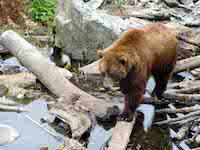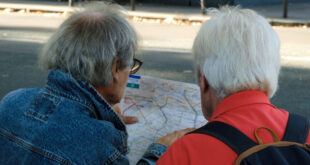 We’re back from Alaska. Travelling on the public ferries and exploring Alaska’s inner passage had been on our bucket list for a long time. As well as enjoying the wonderful wildlife and scenery we could hop off and take our time exploring the small towns along the way. When we discovered that my sister Margreet and brother-in-law Neil shared our dream we decided to just do it and to make the journey together
We’re back from Alaska. Travelling on the public ferries and exploring Alaska’s inner passage had been on our bucket list for a long time. As well as enjoying the wonderful wildlife and scenery we could hop off and take our time exploring the small towns along the way. When we discovered that my sister Margreet and brother-in-law Neil shared our dream we decided to just do it and to make the journey together
Instead of taking the shortest route we stopped over in Vancouver and flew from there to Whitehorse in the Yukon. In Whitehorse we would catch the scenic bus and rail journey to Skagway in Alaska.
Whitehorse
We arrived in the small city of Whitehorse in late spring. It was time to put on merinos and jackets. The weather there was more like Dunedin in winter.
The Yukon is sparsely populated with more moose than people .The total population is only about 36,000 and over 75 percent of these live in the Whitehorse community.
We hired a rental car so we could get out of town and go walking in the countryside for three days. There are bears in this part of the world which filled me with a mixture of fear and excitement.
When we did discover suspicious looking pugmarks on one of the trails and some likely droppings John (being a retired zoo vet) suggested I look through them for traces of human bones if I was worried! But I managed to stay calm and we carried on.
One afternoon wandered for 5km around the Yukon Wildlife Preserve and saw 10 species of northern Canadian mammals in their natural environment (including bison, moose, musk ox and lynx) safely fenced off but close enough for some great photo opportunities.
Nearby was the Bean North Café where fair trade organic coffee is roasted. We’d been told that they serve the best brew in town. We’d been hanging out for a good coffee and weren’t disappointed.
The Yukon Beringia Interpretive Centre Horse
In the last ice age the Yukon was part of the ancient sub-continent Beringia. It stayed mostly ice free so allowing a whole range of now extinct creatures to roam there, including the woolly mammoth and one of Beringia’s ferocious predators, the scimitar cat.
Gold diggers, searching for gold, must have been astounded to unearth some of their skeletal remains. We saw some of these eerie skeletons at the multimedia Beringia Interpretive Centre, as well as the remains of a 26,000 year old mummified horse.
On our last day in Whitehorse Neil and Margaret arrived to join us and it was great to see them. We took a ride along the Yukon River in an old tramcar and sampled the local Yukon Gold beer and a tasty pizza at a local café that evening.
Whitehorse to Skagway
Our trip from Whitehorse to Skagway was great scenic journey- half bus and half train. The bus stopped at one stage as there was a black bear that was feeding on grass at the side of the road seemingly oblivious to a busload of admiring tourists taking snapshots. We weren’t so enthusiastic when the bus stopped again to view two white dots of dall sheep high on the rocky mountain side coming from New Zealand where sheep outweigh people
“Sheep are just dinner to us,” commented Neil
At Carcross we had a glimpse of the world’s smallest desert, not a real desert actually but a few sand dunes which mark the spot where over 10,000 years ago there was a glacial lake bed.
The train from Fraser to Whitehorse dropped 1000 metres over its 46km trip. It is a tourist venture these days but it was built over 100 years ago for the gold miners. A couple of tunnels, wooden viaducts and a narrow gauge led to a slow speed with great views of mountain peaks, waterfalls and lakes .We jostled for photo opportunities on the small platform attached to our carriage .
The journey had started in the ice and snow and ended in lush coastal forest before arriving in Skagway. Here we went through passport formalities with the friendliest customs officer we have ever encountered. We were about to embark on our Alaskan adventure.









Join the Discussion
Type out your comment here:
You must be logged in to post a comment.